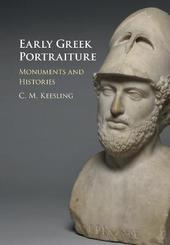
|
Early Greek Portraiture: Monuments and Histories
Hardback
Main Details
| Title |
Early Greek Portraiture: Monuments and Histories
|
| Authors and Contributors |
By (author) Catherine M. Keesling
|
| Physical Properties |
| Format:Hardback | | Pages:324 | | Dimensions(mm): Height 261,Width 183 |
|
| Category/Genre | The arts -miscellaneous
Art History
Ancient and classical art BCE to c 500 CE
History
History of specific subjects |
|---|
| ISBN/Barcode |
9781107162235
|
| Classifications | Dewey:733.3 |
|---|
| Audience | | Professional & Vocational | | Tertiary Education (US: College) | |
|---|
| Illustrations |
3 Maps; 47 Halftones, black and white; 15 Line drawings, black and white
|
|
Publishing Details |
| Publisher |
Cambridge University Press
|
| Imprint |
Cambridge University Press
|
| Publication Date |
3 May 2017 |
| Publication Country |
United Kingdom
|
Description
In this book, Catherine M. Keesling lends new insight into the origins of civic honorific portraits that emerged at the end of the fifth century BC in ancient Greece. Surveying the subjects, motives and display contexts of Archaic and Classical portrait sculpture, she demonstrates that the phenomenon of portrait representation in Greek culture is complex and without a single, unifying history. Bringing a multi-disciplinary approach to the topic, Keesling grounds her study in contemporary texts such as Herodotus' Histories and situates portrait representation within the context of contemporary debates about the nature of arete (excellence), the value of historical commemoration and the relationship between the human individual and the gods and heroes. She argues that often the goal of Classical portraiture was to link the individual to divine or heroic models. Offering an overview of the role of portraits in Archaic and Classical Greece, her study includes local histories of the development of Greek portraiture in sanctuaries such as Olympia, Delphi and the Athenian Acropolis.
Author Biography
Catherine M. Keesling is Associate Professor of Classics at Georgetown University. She is the author of The Votive Statues of the Athenian Acropolis (Cambridge, 2003), as well as journal articles and book chapters on Greek sculpture of the Archaic and Classical periods and its reception, Greek epigraphy and commemorative monuments.
Reviews'The first four chapters of this excellent scholarly study focus primarily on Greek portrait images, their origins, meaning, and various contexts from the Archaic to the late classical periods (sixth-fourth centuries BCE). The last chapter deals with the Hellenistic period down to the Roman conquest of Greece, a time when new portraits of contemporary Greeks were set up in various locations, and a number of old Greek sculptural images were removed to Italy by the Romans, or were reused in Greece by local authorities to represent Roman personages (especially prominent military men and statesmen) by providing them with new identifying inscriptions on their bases. Throughout the book Keesling makes excellent use of ancient primary sources, including dedicatory inscriptions and their significance for understanding the social, political, and religious contexts in which these images were set up. Two appendixes list, and provide pertinent information about, known portrait statues set up (c. 600-300 BCE) at the religious sanctuaries of Olympia and Delphi.' Choice
|